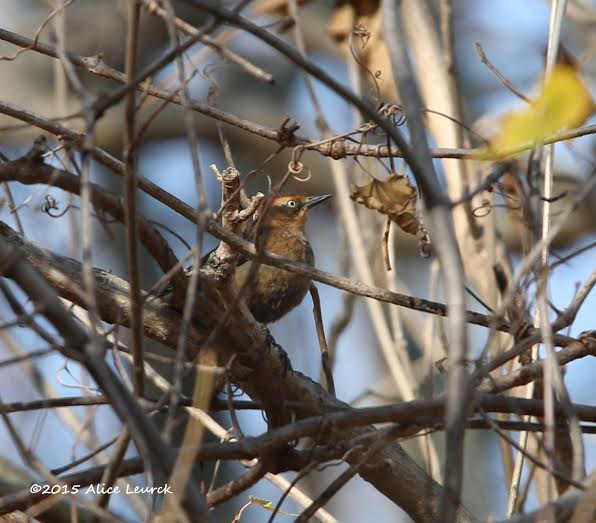
We have seen some great success stories in the birding world in recent years. The Bald Eagle has made a triumphant recovery from the edge of extinction, the Peregrine Falcon, once gone from the Eastern United States, has now returned, and the Osprey has become almost common place where it once had disappeared. Yet today there are many birds much less known that are in serious decline. One of those special birds has become close to my heart, the Rusty Blackbird.
Although the big raptors like eagles and falcons seem much more exciting and can more easily motivate people to protect them, the Rusty Blackbird lacks a press agent and gets little fanfare regarding its plight. But it should not lessen the fact that it is in serious trouble and can use our help .While it may be a challenge to get some people excited about a blackbird we all should be very concerned about the future of this fast disappearing species.

The Rusty Blackbirds overall numbers have been on the decline between 85%and 95% since the early 1970s and are projected to decline an additional 19% in the next 20 years. You don’t have to be a mathematician to see that the Rusty could be headed to extinction. The Rusty Blackbird population is divided up in two groups. The Western Group with a population of one million seems to be stabilizing. But the Eastern Group, which are the birds that winter here, are down to about 30,000 and dropping fast.

Exactly why this is happening is complicated and the experts are not sure where to start. Scientists say a combination of factors may be to blame for the dramatic decline of the Rusty Blackbirds. These include acid rain; mercury accumulation on the breeding ground; changes associated with global warming as their breeding ground in the boreal forests in the north continues to dry up; and the decline of the beaver and beaver ponds which they depend on for nesting and foraging habitat.
Closer to home the destruction, degradation and fragmentation of lowland /wetland forests seriously diminishes their wintering grounds, which they now believe is one of the main reasons the Eastern Group is so vulnerable. Sadly the Rusty does not seem to be on any government agency’s radar so there is not any movement by USFWS or NJDEP to add the Rusty to the Endangered Species list which is where it should be.

Rusty Blackbirds which can be seen in our area from late fall through April can be easily confused with Grackles or even Red-winged Blackbirds, so keeping a close eye on the field marks is important for a positive ID. In winter, male Rusty Blackbirds are recognized by their rusty feather edges, pale yellow eye and buffy eyebrow. Females are gray-brown; they also have rusty feather edges, pale eyes and a bold eyebrow, contrasting with darker feathers right around the eye. Breeding males are dark glossy black.
And as it always does for any species in decline much comes down to habitat loss. The Rusty Blackbirds is no exception; its wintering habitat is also vanishing and that is why preserving wooded wetlands in our area becomes so important to helping these birds hang on and survive.
Rusty Blackbirds prefer bogs, ponds, swamps, and slow streams, and seek out wet areas to feed at the water’s edge for invertebrates and tiny fish, many times wading in the water as they hunt throughout their migration route. In winter they forage in swamps and wet woodlands and will eat native berries, small acorns and seed. They can also visit your backyard bird feeder as many feeder reports come in as the wild food disappears.

Although wooded wetlands are disappearing in our area don’t disregard looking for them in a local patch of woods near your home as they try to survive the winter. In the Meadowlands Losen Slote Creek in Little Ferry is a good place to find wintering Rusties, and they can also be found in Schmidts Woods in Secaucus. Also close by the Celery Farm in Allendale, Borgs Woods in Hackensack, and the Demarest and Tenafly Nature centers provide winter habitat for these wonderful birds. Teaneck Creek Conservancy has been a winter stronghold but is now under remediation. But the restoration plan will make the habitat even better for these birds when it is completed.
We all need to join together to be sure birds like the rusty Blackbird have a future for future generations to come. You can help the Rusty Blackbird by creating native plant wildlife gardens in the backyard and by urging our local towns and counties to preserve more open space, and to plant more native shrubs and trees such as Winterberry Holly, Native Viburnums and Pin Oaks to name a few. Also get involved with conservation groups that work to protect wildlife habitat and work to stop climate change.
You can also help by reporting them to E-bird www.ebird.org . and by posting photos and sightings on our SAVE the RUSTY BLACKBIRD FACEBOOK PAGE
for more info on the Rusty Blackbird go to https://www.audubon.org/field-guide/bird/rusty-blackbird And Visit the Rusty Blackbird working group
